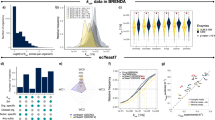Abstract
Genome-scale metabolic reconstructions are powerful resources that allow translation biological knowledge and genomic information to phenotypical predictions using a number of constraint-based methods. This approach has been applied in recent years to gain deep insights into the cellular phenotype role of the genes at a systems-level, driving the design of targeted experiments and paving the way for knowledge-based synthetic biology.
The identification of genetic determinants underlying the variability at the phenotypical level is crucial to understand the evolutionary trajectories of a bacterial species. Recently, genome-scale metabolic models of different strains have been assembled to highlight the intra-species diversity at the metabolic level. The strain-specific metabolic capabilities and auxotrophies can be used to identify factors related to the lifestyle diversity of a bacterial species.
In this chapter, we present the computational steps to perform genome-scale metabolic modeling in the context of comparative genomics, and the different challenges related to this task.
Similar content being viewed by others
References
Brooks AN, Turkarslan S, Beer KD, Lo FY, Baliga NS (2011) Adaptation of cells to new environments. Wiley Interdiscip Rev Syst Biol Med 3(5):544–561. https://doi.org/10.1002/wsbm.136
Telford JL (2008) Bacterial genome variability and its impact on vaccine design. Cell Host Microbe 3(6):408–416. https://doi.org/10.1016/j.chom.2008.05.004
Doolittle WF, Papke RT (2006) Genomics and the bacterial species problem. Genome Biol 7(9):116. https://doi.org/10.1186/gb-2006-7-9-116
Didelot X, Maiden MC (2010) Impact of recombination on bacterial evolution. Trends Microbiol 18(7):315–322. https://doi.org/10.1016/j.tim.2010.04.002
Darmon E, Leach DR (2014) Bacterial genome instability. Microbiol Mol Biol Rev 78(1):1–39. https://doi.org/10.1128/MMBR.00035-13
Medini D, Donati C, Tettelin H, Masignani V, Rappuoli R (2005) The microbial pan-genome. Curr Opin Genet Dev 15(6):589–594. https://doi.org/10.1016/j.gde.2005.09.006
Tettelin H, Masignani V, Cieslewicz MJ, Donati C, Medini D, Ward NL et al (2005) Genome analysis of multiple pathogenic isolates of Streptococcus agalactiae: implications for the microbial “pan-genome”. Proc Natl Acad Sci U S A 102(39):13950–13955. https://doi.org/10.1073/pnas.0506758102.
Tettelin H, Medini D, Donati C, Masignani V (2006) Towards a universal group B Streptococcus vaccine using multistrain genome analysis. Expert Rev Vaccines 5(5):687–694. https://doi.org/10.1586/14760584.5.5.687
Mora M, Veggi D, Santini L, Pizza M, Rappuoli R (2003) Reverse vaccinology. Drug Discov Today 8(10):459–464
Rappuoli R (2001) Reverse vaccinology, a genome-based approach to vaccine development. Vaccine 19(17-19):2688–2691
Monk JM, Charusanti P, Aziz RK, Lerman JA, Premyodhin N, Orth JD et al (2013) Genome-scale metabolic reconstructions of multiple Escherichia coli strains highlight strain-specific adaptations to nutritional environments. Proc Natl Acad Sci U S A 110(50):20338–20343. https://doi.org/10.1073/pnas.1307797110.
Bosi E, Monk JM, Aziz RK, Fondi M, Nizet V, Palsson BO (2016) Comparative genome-scale modelling of Staphylococcus aureus strains identifies strain-specific metabolic capabilities linked to pathogenicity. Proc Natl Acad Sci U S A 113(26):E3801–E3809. https://doi.org/10.1073/pnas.1523199113.
Seemann T (2014) Prokka: rapid prokaryotic genome annotation. Bioinformatics 30(14):2068–2069. https://doi.org/10.1093/bioinformatics/btu153
Altschul SF, Gish W, Miller W, Myers EW, Lipman DJ (1990) Basic local alignment search tool. J Mol Biol 215(3):403–410. https://doi.org/10.1016/S0022-2836(05)80360-2
Kent WJ (2002) BLAT--the BLAST-like alignment tool. Genome Res 12(4):656–664. https://doi.org/10.1101/gr.229202. Article published online before March 2002.
Delcher AL, Phillippy A, Carlton J, Salzberg SL (2002) Fast algorithms for large-scale genome alignment and comparison. Nucleic Acids Res 30(11):2478–2483
Altenhoff AM, Boeckmann B, Capella-Gutierrez S, Dalquen DA, DeLuca T, Forslund K et al (2016) Standardized benchmarking in the quest for orthologs. Nat Methods 13(5):425–430. https://doi.org/10.1038/nmeth.3830
Thiele I, Palsson BO (2010) A protocol for generating a high-quality genome-scale metabolic reconstruction. Nat Protoc 5(1):93–121. https://doi.org/10.1038/nprot.2009.203
Dandekar T, Fieselmann A, Majeed S, Ahmed Z (2014) Software applications toward quantitative metabolic flux analysis and modeling. Brief Bioinform 15(1):91–107. https://doi.org/10.1093/bib/bbs065
Schellenberger J, Que R, Fleming RM, Thiele I, Orth JD, Feist AM et al (2011) Quantitative prediction of cellular metabolism with constraint-based models: the COBRA Toolbox v2.0. Nat Protoc 6(9):1290–1307. https://doi.org/10.1038/nprot.2011.308
Ebrahim A, Lerman JA, Palsson BO, Hyduke DR (2013) COBRApy: COnstraints-Based Reconstruction and Analysis for Python. BMC Syst Biol 7:74. https://doi.org/10.1186/1752-0509-7-74
Berglund AC, Sjolund E, Ostlund G, Sonnhammer EL (2008) InParanoid 6: eukaryotic ortholog clusters with inparalogs. Nucleic Acids Res 36(Database issue):D263–D266. https://doi.org/10.1093/nar/gkm1020
Kaduk M, Riegler C, Lemp O, Sonnhammer EL (2016) HieranoiDB: a database of orthologs inferred by Hieranoid. Nucleic Acids Res 45:D687. https://doi.org/10.1093/nar/gkw923.
Linard B, Allot A, Schneider R, Morel C, Ripp R, Bigler M et al (2015) OrthoInspector 2.0: software and database updates. Bioinformatics 31(3):447–448. https://doi.org/10.1093/bioinformatics/btu642
O’Brien KP, Remm M, Sonnhammer EL (2005) Inparanoid: a comprehensive database of eukaryotic orthologs. Nucleic Acids Res 33(Database issue):D476–D480. https://doi.org/10.1093/nar/gki107
Pryszcz LP, Huerta-Cepas J, Gabaldon T (2011) MetaPhOrs: orthology and paralogy predictions from multiple phylogenetic evidence using a consistency-based confidence score. Nucleic Acids Res 39(5):e32. https://doi.org/10.1093/nar/gkq953
Contreras-Moreira B, Vinuesa P (2013) GET_HOMOLOGUES, a versatile software package for scalable and robust microbial pangenome analysis. Appl Environ Microbiol 79(24):7696–7701. https://doi.org/10.1128/AEM.02411-13
Page AJ, Cummins CA, Hunt M, Wong VK, Reuter S, Holden MT et al (2015) Roary: rapid large-scale prokaryote pan genome analysis. Bioinformatics 31(22):3691–3693. https://doi.org/10.1093/bioinformatics/btv421
Kumar VS, Maranas CD (2009) GrowMatch: an automated method for reconciling in silico/in vivo growth predictions. PLoS Comput Biol 5(3):e1000308. https://doi.org/10.1371/journal.pcbi.1000308
Reed JL, Patel TR, Chen KH, Joyce AR, Applebee MK, Herring CD et al (2006) Systems approach to refining genome annotation. Proc Natl Acad Sci U S A 103(46):17480–17484. https://doi.org/10.1073/pnas.0603364103.
Orth JD, Conrad TM, Na J, Lerman JA, Nam H, Feist AM et al (2011) A comprehensive genome-scale reconstruction of Escherichia coli metabolism--2011. Mol Syst Biol 7:535. https://doi.org/10.1038/msb.2011.65
Author information
Authors and Affiliations
Corresponding author
Editor information
Editors and Affiliations
Rights and permissions
Copyright information
© 2018 Springer Science+Business Media, LLC
About this protocol
Cite this protocol
Monk, J., Bosi, E. (2018). Integration of Comparative Genomics with Genome-Scale Metabolic Modeling to Investigate Strain-Specific Phenotypical Differences. In: Fondi, M. (eds) Metabolic Network Reconstruction and Modeling. Methods in Molecular Biology, vol 1716. Humana Press, New York, NY. https://doi.org/10.1007/978-1-4939-7528-0_7
Download citation
DOI: https://doi.org/10.1007/978-1-4939-7528-0_7
Published:
Publisher Name: Humana Press, New York, NY
Print ISBN: 978-1-4939-7527-3
Online ISBN: 978-1-4939-7528-0
eBook Packages: Springer Protocols




